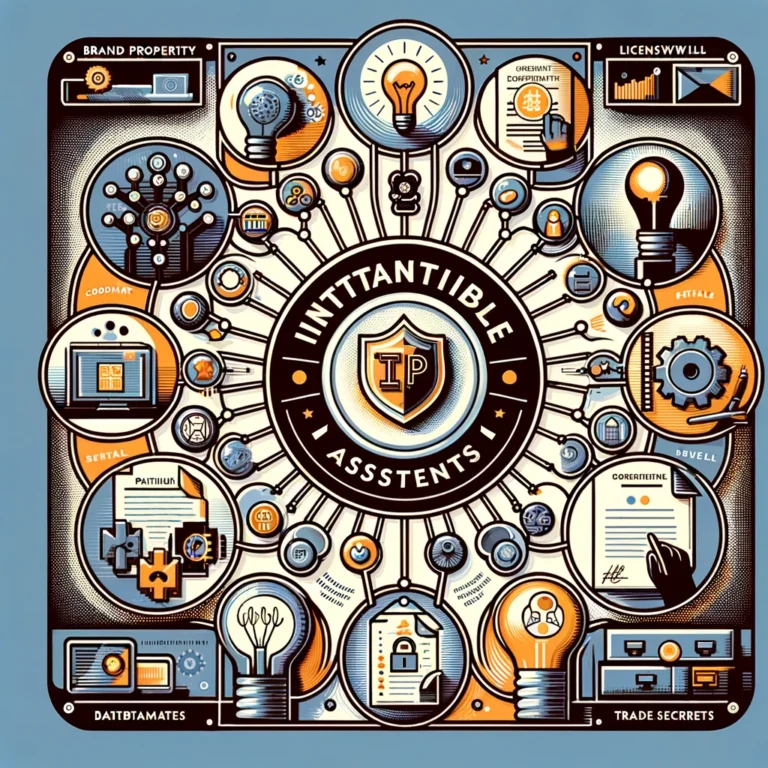- Brand.
- Patents.
- Copyright.
- Goodwill.
- Registered Trademarks.
Intangible assets are crucial for businesses, especially in the modern economy where intellectual property and brand reputation often determine a company’s value more than physical assets do. Understanding types of intangible assets, such as brands, patents, copyrights, goodwill, and registered trademarks, is essential for any business student, particularly those studying IB Business & Management. This detailed analysis will explore these intangible assets, accompanied by industry examples to provide a comprehensive understanding.
Brand
A brand represents a powerful intangible asset, encompassing the perceptions, emotions, and attitudes consumers hold towards a company or its products. A strong brand can create significant competitive advantages, enabling companies to charge premium prices, secure customer loyalty, and gain market share.
Example: Apple Inc. Apple’s brand is synonymous with innovation, quality, and design. The strength of the Apple brand allows the company to maintain high profit margins and a loyal customer base willing to pay premium prices for its products.
Patents
Patents are government-granted exclusive rights to an inventor or their assignee for a limited period, typically 20 years. Patents provide protection for new inventions, preventing others from making, using, selling, or importing the patented invention without permission.
Example: Pharmaceutical Industry Pharmaceutical companies heavily rely on patents to protect their investments in drug development. A patent ensures a company has exclusive rights to produce and sell a new drug, allowing it to recoup R&D costs and earn profits before the patent expires and generic versions enter the market.
Copyright
Copyright is a legal right that grants the creator of original work exclusive rights to its use and distribution, typically for the creator’s lifetime plus 50 to 70 years after their death. Copyrights cover a wide range of creative works, including literature, music, film, and software.
Example: Walt Disney Company Disney’s extensive library of copyrighted works, including movies, TV shows, and characters, provides a continuous revenue stream through box office sales, merchandise, and theme parks. Disney’s careful management and enforcement of its copyrights are central to its business model.
Goodwill
Goodwill is an intangible asset that arises when a company acquires another business for more than the fair value of its tangible and identifiable intangible assets. Goodwill reflects non-physical assets like brand reputation, customer relationships, and intellectual property that contribute to profit generation.
Example: Google’s Acquisition of YouTube When Google acquired YouTube, a significant portion of the purchase price was allocated to goodwill, representing YouTube’s potential for advertising revenue, its user base, and its position as the leading video sharing platform.
Registered Trademarks
Registered Trademarks are distinctive signs or symbols that a company legally registers to represent its products or services, offering legal protection against imitation or misuse. Trademarks help to distinguish a company’s offerings and build brand identity.
Example: Coca-Cola® The Coca-Cola name and logo are registered trademarks, recognizable around the world. The trademark not only protects the brand’s visual identity but also contributes to Coca-Cola’s global brand equity.
Conclusion
Intangible assets such as brands, patents, copyrights, goodwill, and registered trademarks are invaluable to businesses, providing competitive advantages and contributing to long-term profitability and growth. Through the examples of Apple, pharmaceutical companies, Walt Disney, Google’s acquisition of YouTube, and Coca-Cola, it’s evident that effective management and protection of intangible assets are pivotal to achieving and sustaining market leadership. For students of IB Business & Management, understanding the nature, significance, and strategic management of intangible assets is crucial, as these assets increasingly determine the value and competitive positioning of businesses in the global economy.
Frequently Asked Questions about Intangible Assets
What is an Intangible Asset? What type of account is it? ▼
In accounting, intangible assets are classified as **non-current assets** (also called long-term assets) on the Balance Sheet. They are recorded at their cost if purchased externally or, in some cases, if internally developed and meeting specific criteria.
What are the different types of Intangible Assets? ▼
- Intellectual Property: Patents, Copyrights, Trademarks, Trade Names.
- Contract-Based Intangibles: Licenses, Franchises, Lease Agreements, Broadcast Rights, Service or Supply Contracts.
- Marketing-Related Intangibles: Brand Names, Domain Names, Non-compete Agreements.
- Technology-Based Intangibles: Software, Databases, Trade Secrets.
- Customer-Related Intangibles: Customer Lists, Customer Relationships.
- Goodwill: An unidentifiable intangible asset that arises when a company acquires another company for a price higher than the fair value of its identifiable net assets. Goodwill is unique as it is not amortized but tested annually for impairment.
What are considered the "three major types" of Intangible Assets? ▼
- Intellectual Property: Assets protected by legal rights, such as Patents, Copyrights, and Trademarks.
- Contractual/Relationship-Based: Assets arising from agreements or relationships, such as Franchises, Licenses, and Customer Relationships.
- Goodwill: The residual, unidentifiable intangible asset created only through the acquisition of another business, representing the excess of the purchase price over the fair value of identifiable net assets.
Are all types of Intangible Assets amortized? ▼
- Intangible assets with a **finite (limited) useful life** (e.g., patents with a legal life, licenses for a specific period) are amortized over their useful life. Amortization is the systematic allocation of the asset's cost over the periods benefited.
- Intangible assets with an **indefinite (unlimited) useful life** (e.g., trademarks with indefinite renewal, Goodwill) are *not* amortized. Instead, they are tested annually (or more frequently if impairment indicators exist) for impairment. If the asset's carrying amount exceeds its fair value, an impairment loss is recognized. Goodwill is the most prominent example of an intangible asset with an indefinite life.

